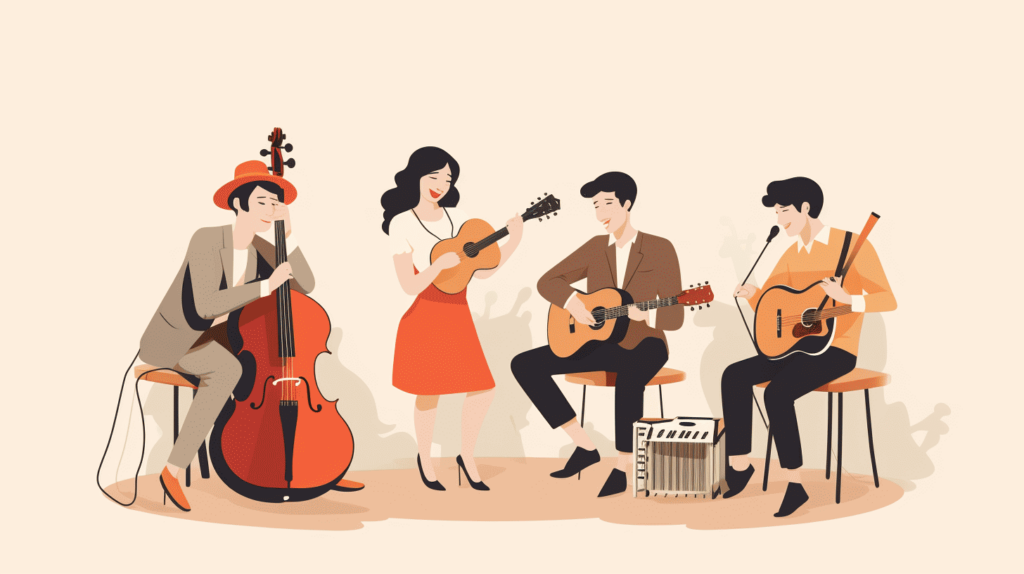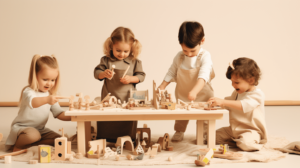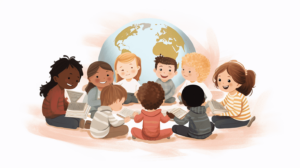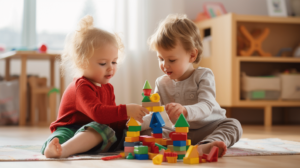
Sibling Relationships – Tips for Encouraging Bonding
Discover effective tips for nurturing sibling relationships and fostering a strong bond between siblings. Create lasting connections and promote harmony.
Immerse yourself in this magical world of melody where toddlers and their siblings can collectively unlock their potential, deepen their bond, and simply have fun. Did you know that the harmonious blend of notes has the power to stimulate cognitive abilities, encourage emotional expression, and foster social skills in young children?
Designed to add a little rhythm to their daily life, this journey will explore the enriching world of music and its significant impact on early childhood development. We’ll also shed light on some interactive musical activities that you and your little ones can indulge in. By the end of reading this, we are sure you will be ready to turn up the volume and groove with your family. So, shall we dance to the beats of togetherness? Let’s get started!
Do you remember the soothing lullabies that sent you to sleep at night or the vibrant nursery rhymes that taught you to thread syllables together? Music has been a part of your growth journey since you were little, shaping your cognitive, emotional, and social development. But do you know how pivotal this playful medium is for the early growth stages? Let’s dive into the world of rhythm and beats and discover the importance of music in early childhood.

One of the essential starters in our discussion is cognitive development 🧠. To put it simply, it’s about how children perceive the world around them. Here’s where music comes marching with its band of benefits:
In all, the catchy rhythms, dancing beats, and soothing melodies do more than providing entertainment – they build much-needed cognitive foundations.
While the brain is getting a tune-up from the melodies, let’s not forget about tending to the heartstrings. Music taps into the depth of emotions often in ways words fail to do so:
Like a symphony of feelings, music reverberates within the chambers of a child’s heart, enhancing their emotional intelligence.
And guess what? The music doesn’t stop at cognition or emotion. It dances its way into social relationships as well:
Yes, that’s true! From enhancing teamwork to fostering respect – music is a social butterfly fluttering in the garden of early childhood development.
Exploring the fascinating rhythm of growth and development through the notes of music in early childhood, we see a harmonious symphony of cognitive, emotional, and social growth. So, whether it’s singing a nursery rhyme, learning a musical instrument, or just shaking a rattle along with a song, let the music play. It is setting the stage for holistic development in your child’s life – note by note, beat by beat. 🎵🎶
The connection children create with music at a tender age is a priceless treasure, acting as an indispensable tool for their development. It’s from this perspective that engaging your toddlers and older siblings in musical activities can be a game-changer. 🎼 These activities not only promote bonding but also stimulate their cognitive skills, aiding in language development, social interaction, and motor coordination. We’ll examine four captivating musical activities that can give your little ones a great headstart.
Singing is an age-old activity that transcends cultures and generations. It’s a fun way that can help children learn new words while improving their speech through the rhythm, rhyme, and repetition intrinsic to songs. 🎵 Get your kids to join in choruses or sing along to simple songs. Introducing action songs like ‘The Wheels on the Bus’ or ‘Five Little Ducks’ can bring even more fun as they get to mimic actions while singing. Also, encourage older siblings to lead in singing, creating a heartwarming family choir right in your living room.
Children love to move and dance. It’s a natural mode of self-expression that simultaneously develops motor skills, balance, and coordination. 👯♀️ Playing music and encouraging your children to dance not only helps them stay active but also aids them in understanding rhythm and beat. Turn your living room into a dance floor and let loose with your kids! Don’t forget to incorporate ‘freeze dance’ into the mix. When the music stops, everyone freezes – a superb addition to the fun!
Introducing musical instruments into the mix is a fantastic way to expose your toddlers to various sounds and rhythms while enhancing fine motor skills. 🎷 Kids can use simple instruments like shakers, tambourines, or even a home-made drum set. The older siblings can get a chance to showcase their skills, guiding the younger ones in creating their melodious tune.
Notably, musical games can be fully engaging, making your kids look forward to these bonding sessions. Games such as ‘Pass the Beat’ and the musical chairs harness the unifying power of music. They also help in teaching children to take turns, listen carefully, and act swiftly.
You may notice these activities fostering a deep love for music in your young ones that they’ll carry through their lives. It’s amazing how music incorporated in these simple ways can contribute to holistically enriching your child’s overall development. Ultimately, these musical moments are also opportunities to make beautiful family memories! 🎶
Engaging in musical activities together can be a wonderful way for individuals to achieve a closer bond. Whether it’s between friends, families, or couples, shared musical experiences often foster deeper connections. This section will outline some effective tips for encouraging bonding through music. These include selecting age-appropriate musical activities, making music a fun experience, and inspiring collaboration in musical pursuits. Let’s delve into each one of these facets.
To create a positive musical bonding experience, it’s vital to consider the age of the participants. Here are a few tips:
Selecting the right activity for the right age group can play a definite role in strengthening relationships through music.
While music is a serious art form, it doesn’t mean it can’t be fun! One key to fostering a deep bond through music is to ensure the experience is enjoyable.
“Music is an outburst of the soul.” – Frederick Delius
A light-hearted approach to musical activities can make the experience fun and help to build stronger connections.
True bonding often comes from working together towards a shared goal. In the world of music, this collaboration can take many forms.
Each of these activities requires teamwork, communication, and collaboration – all things that strengthen bonds.
Music offers a unique opportunity to build connections with others. By selecting age-appropriate activities, ensuring a fun environment, and encouraging collaboration, we can foster a deeper bond through our shared love of music. 🎼🎵
Music is more than just a source of entertainment—it’s a powerful means of connection and communication. 🎶 Parents play an instrumental role in establishing a musical bond with their children, which not only nurtures their artistic interests but also aids in their emotional and intellectual development. The question is, how can parents stimulate the love for music in their kids and foster an environment conducive to musical growth? This article provides insights on creating a musical environment at home and engaging in musical activities with them.
Making music a part of your home environment is step one in forging a musical bond with your child. Follow these tips to instill a love for melodies and rhythms in your child:
An immersive approach involving active participation can work wonders. Not only does it inspire your child to take a keen interest but when you as a parent show interest, it adds a layer of trust and bonding.
Remember, the goal of fostering a musical environment isn’t to cultivate the next Beethoven or Beyoncé. It’s about opening a world of expression, creativity, and bonding with your child. So, let’s turn up the volume and start making some joyful noise together! 🎵
Music is much more than just a means of entertainment – it’s a catalyst for sparking connections, enhancing cognitive growth, and enriching the emotional wellbeing in toddlers and their siblings. As we’ve learned throughout this article, regular musical activities are invaluable in the emotional, cognitive, and social development of children.
These activities, whether singing, dancing, or playing musical instruments, offer a fun arena for kids to collaborate, learn from each other, and develop stronger bonds. For parents, creating an atmosphere that promotes joyful musical exploration and emphasizes participation can make all the difference in nurturing an affectionate sibling relationship.
While every child is unique and might engage with music differently, the key is to make the process enjoyable and relaxed. Caution needs to be taken not to force children into musical activities, but motivate them through encouragement and setting an example. Remember, the goal isn’t to produce the next Mozart, but to connect siblings more closely, create a lifetime of fond memories, and facilitate holistic development 🎶.
In the end, the harmonious notes of music can serve as a beautiful glue, binding siblings together, creating a symphony of love and companionship that lasts a lifetime. Like a soul-stirring lullaby or a sprightly dance tune, the magical notes of music hold the power to bring hearts together in the sweetest harmony 🎵❤️.
Even if it sounds like a ‘fantasia,’ as parents, you have all the ‘symphony’ you need to make it a reality. So, let’s hit the play button and start the music.
Some musical activities for toddlers and siblings include singing nursery rhymes together, playing musical instruments like drums or xylophone, creating a homemade band using household items, dancing to music, and exploring different musical genres.
Music helps in the cognitive, language, and emotional development of toddlers. It also encourages bonding and communication between siblings, promotes creativity, and aids in the development of fine and gross motor skills.
Music offers a shared experience for toddlers and siblings, allowing them to engage in collaborative activities, express themselves creatively, and have fun together. It creates a positive and joyful atmosphere that strengthens their bond and fosters a sense of togetherness.
Singing nursery rhymes with toddlers and siblings promotes language development, vocabulary expansion, and enhances memory skills. It also helps with rhythm and rhyme recognition, improves listening skills, and encourages early literacy.
You can incorporate music into daily routines by singing bedtime songs, creating a playlist for mealtime, playing calming lullabies during naptime, and using music as a background for playtime or craft activities. Additionally, you can encourage siblings to sing together while doing chores or getting ready for the day.
Be the first to See our Posts and latest Guides, and Special Offers like Lovelycheeks on Facebook or follow us on Pinterest!

Discover effective tips for nurturing sibling relationships and fostering a strong bond between siblings. Create lasting connections and promote harmony.

Discover creative and interactive activities for toddlers and siblings to enjoy together. Keep the little ones entertained with fun and engaging ideas.

Discover fun and interactive activities for toddlers and siblings during storytime. Engage their imagination and create lasting memories with these ideas.

Discover fun and engaging activities to help enhance your toddler’s language skills and foster communication between siblings. Start teaching language skills early.